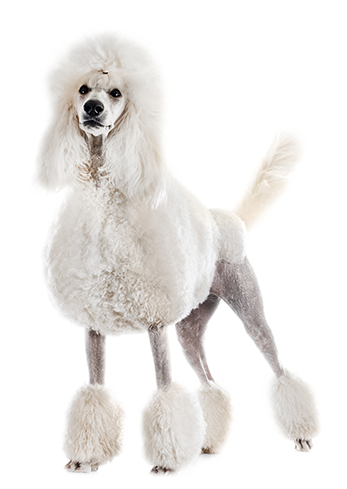
ALL ABOUT DOODLES –
YOUR QUESTIONS ANSWERED

ALL ABOUT DOODLES –
YOUR QUESTIONS ANSWERED

ALL ABOUT DOODLES YOUR QUESTIONS ANSWERED
Over the past few years, you’ve probably noticed that poodle mixes have become very popular. Many people these days call these poodle mixes “Doodles,” and many common poodle mixes have their own name. For example, a mix with a Golden Retriever is a Goldendoodle, or sometimes a Groodle, while a mix with a Labrador Retriever is a Labradoodle. These two are among the earliest and most common types of Doodle.
So why are Doodles so popular? Why did so many people fall in love with this crossbreed in particular?
It’s important to keep in mind that there are over 50 varieties of Doodle, and they come in all shapes, sizes, and colors. There are minis, toys, standards, and teacups. You can find Teddy Bear, short, long, curly and wavy hair. Every Doodle is unique.
While all Doodles are part Poodle, some will look more like a Poodle than others. For example, H1B Doodles, which have 3 Poodle grandparents, will tend to look more like Poodles than H1 Doodles, which only have 2 Poodle grandparents.
Finally, there is a lot of variance in appearance even among similar mixes. For example, among H1 Labradoodles you will find some that are more like Poodles, and some that are more like Labrador Retrievers, not just in appearance, but also in personality and temperament.
A Doodle’s personality will often be a combination of or compromise between a Poodle’s and the other breed. Poodles are known to be intelligent, alert, active, playful, obedient, and trainable. They are among the most intelligent breeds of dogs, and usually try their best to make you happy. They’re not very aggressive but do have watchdog tendencies and will bark to alert you of noises or visitors.
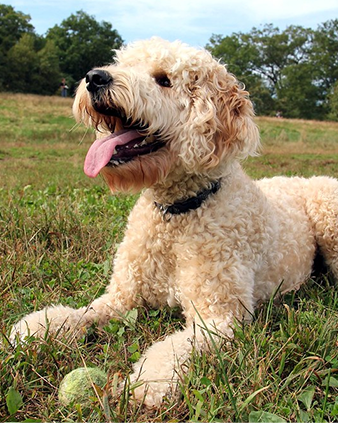
Just like a Doodle’s appearance and personality will probably be somewhere between that of a Poodle and the other breed, the same is true for energy levels.
Despite their reputation as show dogs, Poodles are very athletic and thrive when they get lots of exercise. Originally, they were bred to retrieve ducks during a hunt, so they are keen to play fetch and run around a lot and have plenty of energy.
While Poodles are known to be well-behaved and easy to train, Doodles can vary, so it’s important to get to know the personality of each one and come up with a training routine to curb some of the less desirable behaviors. Doodles can be quite the barkers and may experience barrier frustration and short attention spans.
They can be chewers, jumpers, or humpers, and easily excitable around new people and other dogs. They also tend to have a prey drive and love to chase things, and so are hyped up around moving objects and may be difficult to calm down.
One thing to be prepared for is the energy and curiosity of the adolescent Doodle, for whom constant mouthing, jumping, and leash-pulling is common behavior. Expect these teens to be hyper and need lots of exercise, and protect anything you don’t want them to chew up.
As you can see, training is very important for Doodles, who have loads of curiosity and energy which needs to be harnessed in a healthy way.
The Poodle breed has been traced back as far as the Middle Ages, and so there were certainly Doodles back then as well. However, it wasn’t until recently that Poodle crossbreeds took off in popularity. In the mid-20th century, an attempt was made to popularize Cockapoos, a Poodle-Cocker Spaniel mix, but it didn’t quite catch on.
Over the past few years, you’ve probably noticed that poodle mixes have become very popular. Many people these days call these poodle mixes “Doodles,” and many common poodle mixes have their own name. For example, a mix with a Golden Retriever is a Goldendoodle, or sometimes a Groodle, while a mix with a Labrador Retriever is a Labradoodle. These two are among the earliest and most common types of Doodle.
So why are Doodles so popular? Why did so many people fall in love with this crossbreed in particular?
It’s important to keep in mind that there are over 50 varieties of Doodle, and they come in all shapes, sizes, and colors. There are minis, toys, standards, and teacups. You can find Teddy Bear, short, long, curly and wavy hair. Every Doodle is unique.
While all Doodles are part Poodle, some will look more like a Poodle than others. For example, H1B Doodles, which have 3 Poodle grandparents, will tend to look more like Poodles than H1 Doodles, which only have 2 Poodle grandparents.
Finally, there is a lot of variance in appearance even among similar mixes. For example, among H1 Labradoodles you will find some that are more like Poodles, and some that are more like Labrador Retrievers, not just in appearance, but also in personality and temperament.
A Doodle’s personality will often be a combination of or compromise between a Poodle’s and the other breed. Poodles are known to be intelligent, alert, active, playful, obedient, and trainable. They are among the most intelligent breeds of dogs, and usually try their best to make you happy. They’re not very aggressive but do have watchdog tendencies and will bark to alert you of noises or visitors.

Just like a Doodle’s appearance and personality will probably be somewhere between that of a Poodle and the other breed, the same is true for energy levels.
Despite their reputation as show dogs, Poodles are very athletic and thrive when they get lots of exercise. Originally, they were bred to retrieve ducks during a hunt, so they are keen to play fetch and run around a lot and have plenty of energy.
While Poodles are known to be well-behaved and easy to train, Doodles can vary, so it’s important to get to know the personality of each one and come up with a training routine to curb some of the less desirable behaviors. Doodles can be quite the barkers and may experience barrier frustration and short attention spans.
They can be chewers, jumpers, or humpers, and easily excitable around new people and other dogs. They also tend to have a prey drive and love to chase things, and so are hyped up around moving objects and may be difficult to calm down.
One thing to be prepared for is the energy and curiosity of the adolescent Doodle, for whom constant mouthing, jumping, and leash-pulling is common behavior. Expect these teens to be hyper and need lots of exercise, and protect anything you don’t want them to chew up.
As you can see, training is very important for Doodles, who have loads of curiosity and energy which needs to be harnessed in a healthy way.
The Poodle breed has been traced back as far as the Middle Ages, and so there were certainly Doodles back then as well. However, it wasn’t until recently that Poodle crossbreeds took off in popularity. In the mid-20th century, an attempt was made to popularize Cockapoos, a Poodle-Cocker Spaniel mix, but it didn’t quite catch on.
Over the past few years, you’ve probably noticed that poodle mixes have become very popular. Many people these days call these poodle mixes “Doodles,” and many common poodle mixes have their own name. For example, a mix with a Golden Retriever is a Goldendoodle, or sometimes a Groodle, while a mix with a Labrador Retriever is a Labradoodle. These two are among the earliest and most common types of Doodle.
So why are Doodles so popular? Why did so many people fall in love with this crossbreed in particular?
It’s important to keep in mind that there are over 50 varieties of Doodle, and they come in all shapes, sizes, and colors. There are minis, toys, standards, and teacups. You can find Teddy Bear, short, long, curly and wavy hair. Every Doodle is unique.
While all Doodles are part Poodle, some will look more like a Poodle than others. For example, H1B Doodles, which have 3 Poodle grandparents, will tend to look more like Poodles than H1 Doodles, which only have 2 Poodle grandparents.
Finally, there is a lot of variance in appearance even among similar mixes. For example, among H1 Labradoodles you will find some that are more like Poodles, and some that are more like Labrador Retrievers, not just in appearance, but also in personality and temperament.
A Doodle’s personality will often be a combination of or compromise between a Poodle’s and the other breed. Poodles are known to be intelligent, alert, active, playful, obedient, and trainable. They are among the most intelligent breeds of dogs, and usually try their best to make you happy. They’re not very aggressive but do have watchdog tendencies and will bark to alert you of noises or visitors.

Just like a Doodle’s appearance and personality will probably be somewhere between that of a Poodle and the other breed, the same is true for energy levels.
Despite their reputation as show dogs, Poodles are very athletic and thrive when they get lots of exercise. Originally, they were bred to retrieve ducks during a hunt, so they are keen to play fetch and run around a lot and have plenty of energy.
While Poodles are known to be well-behaved and easy to train, Doodles can vary, so it’s important to get to know the personality of each one and come up with a training routine to curb some of the less desirable behaviors. Doodles can be quite the barkers and may experience barrier frustration and short attention spans.
They can be chewers, jumpers, or humpers, and easily excitable around new people and other dogs. They also tend to have a prey drive and love to chase things, and so are hyped up around moving objects and may be difficult to calm down.
One thing to be prepared for is the energy and curiosity of the adolescent Doodle, for whom constant mouthing, jumping, and leash-pulling is common behavior. Expect these teens to be hyper and need lots of exercise, and protect anything you don’t want them to chew up.
As you can see, training is very important for Doodles, who have loads of curiosity and energy which needs to be harnessed in a healthy way.
The Poodle breed has been traced back as far as the Middle Ages, and so there were certainly Doodles back then as well. However, it wasn’t until recently that Poodle crossbreeds took off in popularity. In the mid-20th century, an attempt was made to popularize Cockapoos, a Poodle-Cocker Spaniel mix, but it didn’t quite catch on.
Some Popular Types of Doodles
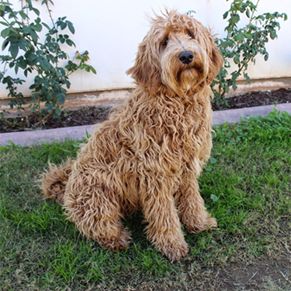
Height: 17 to 24 inches
Weight: 30 to 65 pounds
Lifespan: 12 to 16 years
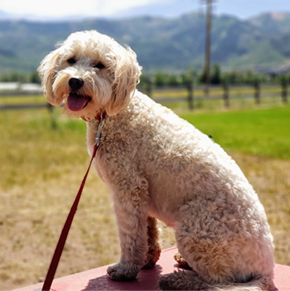
Height: 13 to 24 inches
Weight: 15 to 90 pounds
Lifespan: 10 to 15 years
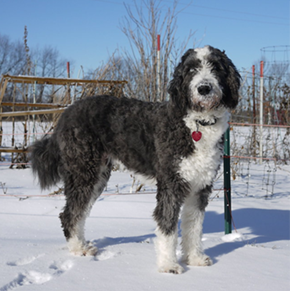
Height: 10 to 25 inches
Weight: 25 to 100 pounds
Lifespan: 10 to 13 years
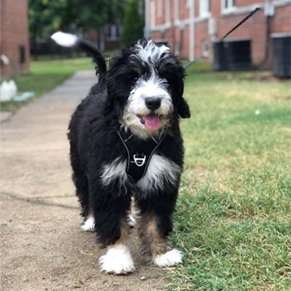
Height: 12 to 29 inches
Weight: 10 to 100 pounds
Lifespan: 12 to 18 years
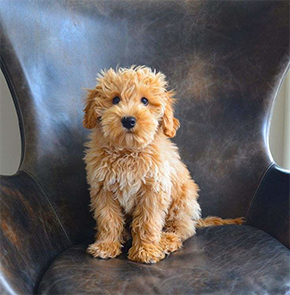
Height: 9 to 14 inches
Weight: 8 to 25 pounds
Lifespan: 10 to 15 years
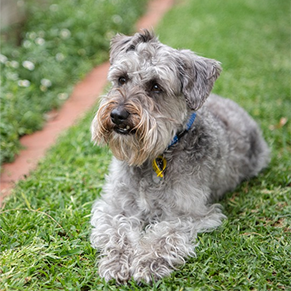
Height: 12 to 15inches
Weight: 7 to 76 pounds
Lifespan: 10 to 18 years
Some Popular Types of Doodles

Height: 17 to 24 inches
Weight: 30 to 65 pounds
Lifespan: 12 to 16 years

Height: 13 to 24 inches
Weight: 15 to 90 pounds
Lifespan: 10 to 15 years

Height: 10 to 25 inches
Weight: 25 to 100 pounds
Lifespan: 10 to 13 years

Height: 12 to 29 inches
Weight: 10 to 100 pounds
Lifespan: 12 to 18 years

Height: 9 to 14 inches
Weight: 8 to 25 pounds
Lifespan: 10 to 15 years

Height: 12 to 15inches
Weight: 7 to 76 pounds
Lifespan: 10 to 18 years
You may hear people talking about “F1 Goldendoodles” or “F1B Labradoodles” and wonder what this is all about. It’s pretty simple. If a Doodle is “F1” it means that it is a “first cross” so that each of its parents is a purebred. It has two Poodle grandparents and two grandparents of the other breed.
Doodles have a tendency to mat unless brushed regularly or kept in a short cut, and this surprises many owners. In fact, Doodles have a very bad reputation with many groomers because many owners only bring them in when they’re badly matted. As a result, Doodles should be given short haircuts unless there is a commitment to regular and consistent brushing. Mats can be very painful and lead to sores and skin infections, so a monthly visit to the groomer is also recommended.
Bathing your Doodle regularly and drying them properly is critical for avoiding matting and knotting and keeping their fur fluffy. A Doodle’s fur tends to resemble human hair more than most breeds, and as such, they have significantly more issues with trapped dirt and debris. If you can’t get your Doodle to the vet for a bath, you’ll have to do it yourself. They generally need a bath every 2-8 weeks.
You may hear people talking about “F1 Goldendoodles” or “F1B Labradoodles” and wonder what this is all about. It’s pretty simple. If a Doodle is “F1” it means that it is a “first cross” so that each of its parents is a purebred. It has two Poodle grandparents and two grandparents of the other breed.
Doodles have a tendency to mat unless brushed regularly or kept in a short cut, and this surprises many owners. In fact, Doodles have a very bad reputation with many groomers because many owners only bring them in when they’re badly matted. As a result, Doodles should be given short haircuts unless there is a commitment to regular and consistent brushing. Mats can be very painful and lead to sores and skin infections, so a monthly visit to the groomer is also recommended.
Bathing your Doodle regularly and drying them properly is critical for avoiding matting and knotting and keeping their fur fluffy. A Doodle’s fur tends to resemble human hair more than most breeds, and as such, they have significantly more issues with trapped dirt and debris. If you can’t get your Doodle to the vet for a bath, you’ll have to do it yourself. They generally need a bath every 2-8 weeks.
You may hear people talking about “F1 Goldendoodles” or “F1B Labradoodles” and wonder what this is all about. It’s pretty simple. If a Doodle is “F1” it means that it is a “first cross” so that each of its parents is a purebred. It has two Poodle grandparents and two grandparents of the other breed.
Doodles have a tendency to mat unless brushed regularly or kept in a short cut, and this surprises many owners. In fact, Doodles have a very bad reputation with many groomers because many owners only bring them in when they’re badly matted. As a result, Doodles should be given short haircuts unless there is a commitment to regular and consistent brushing. Mats can be very painful and lead to sores and skin infections, so a monthly visit to the groomer is also recommended.
Bathing your Doodle regularly and drying them properly is critical for avoiding matting and knotting and keeping their fur fluffy. A Doodle’s fur tends to resemble human hair more than most breeds, and as such, they have significantly more issues with trapped dirt and debris. If you can’t get your Doodle to the vet for a bath, you’ll have to do it yourself. They generally need a bath every 2-8 weeks.